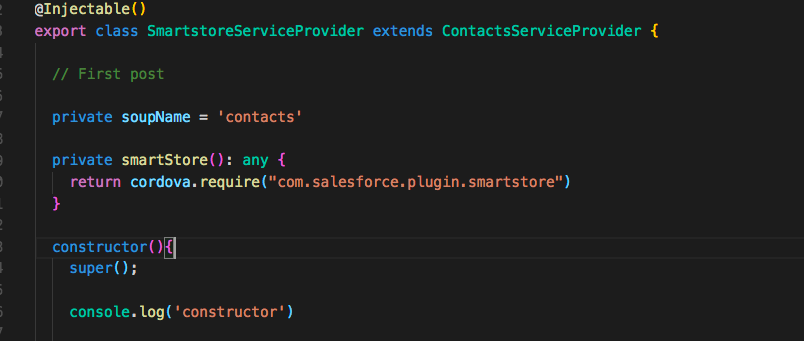
Salesforce Mobile SDK and Ionic – TypeScript Inheritance Part II
Brett M. Nelson - Monday, January 22, 2018
In Salesforce Mobile SDK and Ionic – TypeScript Inheritance we used extend to inherit from the ContactsServiceProvider in our SmartstoreServiceProvider. This allows us to move ahead with adding features to our SmartstoreServiceProvider without having to create each necessary method call when we replace the ContactsServiceProvider. Let's look at how.
What's Inherited
Some of the methods that we were missing: getContact and deleteContact we not implemented by our SmartstoreServiceProvider. Since we inherited from a class that had implementations of those methods we are able to call them on the class. For right now the implementation of getContact and deleteContact behave exactly like when we used the ContactsServiceProvider as our service since those are the methods we are calling.
We can override existing implementations by by implementing our new version of the method in our SmartstoreServiceProvider. This means eventually we will technically have two different getContact and deleteContact we will still be able to specify the correct method by using either the this keyword to reference the one implemented at the current level of inheritance or by using the super keywork to reference the base class.
In our case the parent or base class is
ContactsServiceProvider.SmartstoreServiceProvideris a child or subclass.
Speaking of super...
super
The super keyword is used to reference the base class from the subclass. This way we can still use the functionality provided by the base class and adjust it to our needs. We did this in the constructor when we called super(); before we could access the context of this.
In the constructor calling super(); was calling the constructor of the base class. This allows for the base class to be properly instantiated, or created, before we start changing values it might assign.
We can also use the super keyword to access methods besides the constructor. We may decide to use the base class version of getContact in our subclass after we override getContact to perform an action or even to take no parameter and use a hard coded string to get the contact.
Example Override
getContact() { console.log('SmartstoreServiceProvider.getContact'); super.getContact('003j0000008CVYlAAO') .then(results => { // do something cool here }); }
Protip don't use hard coded values.
This is a little contrived example but you can see how it works when you override a method from a base class with a new implementation in the subclass.
Conclusion
Don’t forget to sign up for The Weekly Stand-Up! to receive free the WIP Developer.com weekly newsletter every Sunday!